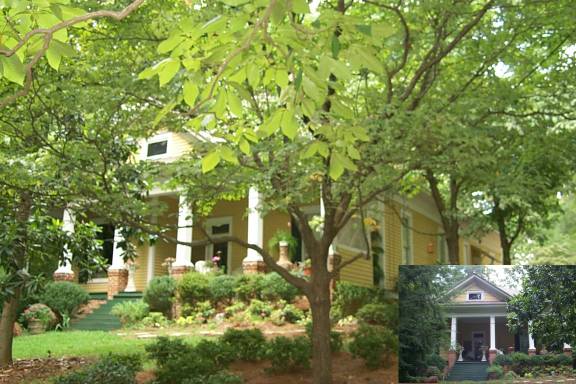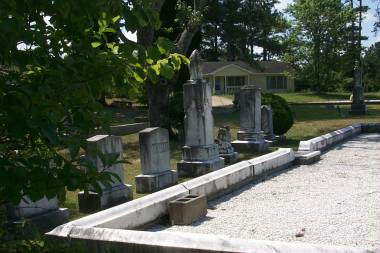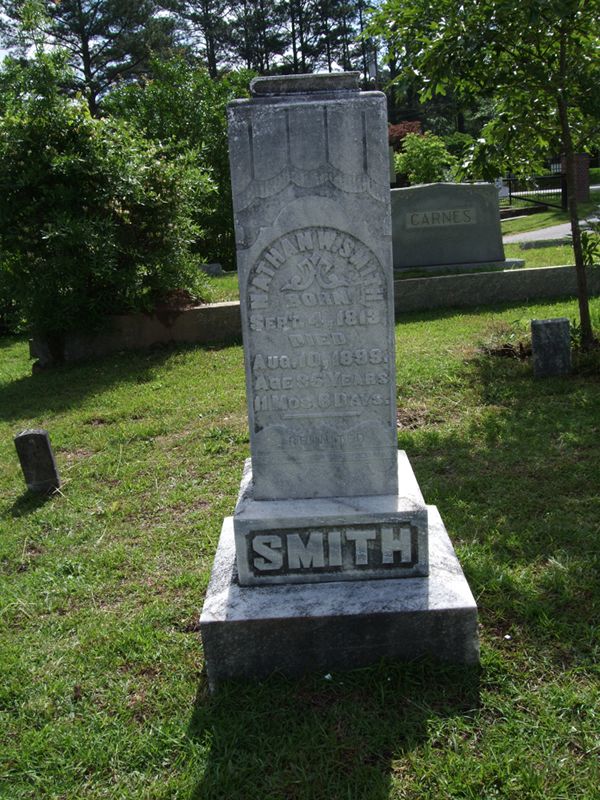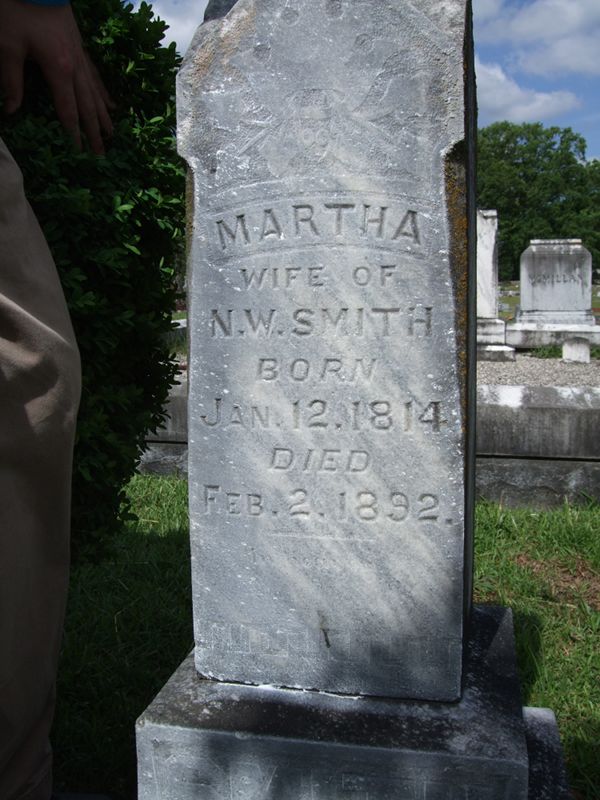Nathan Williamson Smith
(1813-1899)

Biographical Sketch of Nathan W. Smith
Georgia churches owe a debt of gratitude to the sacrificial labors of Nathan Williamson Smith. During his lifetime he preached in 40 different counties in the state and was the only preacher at different times for fourteen of those churches.
He was born about 40 miles from Greensboro in Rockingham County, North Carolina, September 4, 1813. His parents were Methodists, and he and his four brothers were raised in that way. His father died in 1840, not being a member of any church, but later in advanced years, his mother obeyed the gospel of Christ. He had very little formal education by his own admission. While attending little "field" school he had access to about six books. Nevertheless he taught school in his life as well as farming as a livelihood.
Around the year 1807, a group of Republican Methodists, influenced by the James O'Kelley Movement, moved from North Carolina to settle near Skull Shoals in Clarke (now Oconee) County. They called the church Republican. (Republican means "Free," a title O'Kelley took when he left the Methodists in 1792.) In 1831, the young Smith, and his family moved into the area and began associating with the group.
In 1832, at about the age of nineteen Smith was baptized by Arthur Dupree, a Christian Evangelist from DeKalb County, Georgia, preaching in a campmeeting, at Skull Shoals. A few months after his baptism he attended another one of Dupree's revival meetings in Wilkes County, Georgia where he met his future wife, Miss. Martha White. The two were married on January 21, 1834, and lived together more than fifty-eight years before she died February 2, 1892. They had three sons and three daughters.
In about 1836 he began working in the ministry as a preacher. In November 1837, a religious paper from Evergreen, South Carolina was started by John M. Barnes, and his associate editor Charles F.M. Shehane. Many issues included information about the work in Georgia. Some of these issues came to the hands of Smith and others at Republican. In it he heard the stories of Sheldon C. Dunning and Christian Herman Dasher in South Georgia who in 1819 gave up their denominational ties to go back to the Bible and simply be New Testament Christians. In it he most likely heard of the writings of Alexander Campbell, because it was in 1837 when he subscribed to the Millennial Harbinger and kept it until the Civil War. Initially Smith rejected the teachings of Campbell, but later accepted them openly.
Early in 1838 he wrote concerning his work:
I am traveling and trying to preach the word of God, the only traveling preacher in the reformation in the whole state of Georgia that I know of, and I have left my family to spend the year in the good cause, and have not the promise of one cent as a reward for my time, from any man or set of me.
In 1842 an uprising among the membership at Republican announced that the teachings of Campbell were to cease from the pulpit. When this continued, a small group left the church. Following this division, N.W. Smith led in the reorganization of the Republican Church. He induced the group to change the name to Antioch since, "the disciples were called Christians first at Antioch" (Acts 11:26. Thus, the group began meeting weekly in 1844. Smith later wrote:
The brethren in 1844, then numbering near one hundred, concluded to send me out as evangelist, saying, they would support my family. They kept me in the field for three years. During these three years I traveled extensively in Georgia, Alabama and South Carolina, and I immersed a great many persons and organized small congregations, that were built up from very small beginnings to to large and respectable churches. Those were days of trial, labor and sacrifice. Part of the time I was in feeble health, but preached many a sermon from one to two and a half hours long, with only a biscuit and glass of water for my breakfast.
Churches that Smith assisted in establishing were: The County Line Church of Christ, on the southern tip of Fayette County, Georgia. One of the first members was Robert Westmoreland, who later contributed land for a building to be built. (That church still meets today, now called, County Line Christian Church. Westmoreland and other members buried in the adjacent cemetery); Mount Vernon Church of Christ, Walton County, 1842; Union Church of Christ, Oconee County (formerly Bethany, Jackson County), began in 1863, and others.
In his travels he spent his time mainly in preaching to old brethren, not one of whom would make a prayer in public, or raise a tune, or hold it up, when it was raised, so he had to sing, and pray, and preach all by himself.
When Alexander Campbell came and preached in Augusta, Georgia in 1845, Smith was present to hear the great evangelist. He related a story concerning their meeting in the Christian Standard, May 24, 1892, p. 166. He said:
. . . . After I saw Bro. Campbell in Augusta, in 1845, he sent me a lot of books to sell, of which I knew nothing until I received the invoice. I subsequently ordered from him books, and also Bro. H.S. Bosworth, of Cincinnati. But selling books at that time was rather slow an not a very profitable business. My main object was to have them circulated and read by the brethren and friends.. I also sent and bought some tracts to circulate among the people who would read them.
After Campbell's visit, Smith and Dr. Daniel Hook rode together to evangelize in Georgia. In 1845, while at the County Line Church in Fayette County, they met the Fears brothers, William Sadler and Augustus Browder "Buck." They had moved into the Hampton area some years before and had heard of the work of Smith at County Line. They traveled 25 miles from their homes in Hampton, Georgia to hear the gospel preached, to which they accepted and obeyed the gospel. This began the church at Berea in Hampton, Georgia.
In 1848, or 1849 Smith moved to a small town north of Atlanta called Acworth. He bought a small farm, and was one of the first school teachers there in the small village. There his daughter Anne married R.M. Mitchell. Both of these people were Christians and taught school in Acworth.
Meanwhile Smith continued his travels preaching. In 1849 he spent the whole year, at his own expense traveling through Georgia to promote unity among churches. While living north of Atlanta, he was the main preacher for Hampton and County Line in Fayette, as well as his duties in Acworth. This was about 75 miles of horseback travel between congregations.
After the Civil War, the war-torn brethren of Georgia suffered economically, along with all other people of the south. However Georgia was especially devastated by Sherman's deadly march to the sea. During that time N.W. Smith became a very close friend of the new editor of the Gospel Advocate, David Lipscomb. In Vol. 21 No. 35 - Aug. 28, 1878. p. 550, Lipscomb introduces a letter from Smith saying, "We are sorry indeed, that after years of labor and toil he should thus be troubled and harassed in his old age. We hope some brother or friend will relieve him." In the letter Bro. Smith explained,
. My Dear Bro. Lipscomb: You have done me many favors, for which I trust I am still very grateful. I am in trouble and greatly distressed. Weill you say to your readers that if any of them want a good farm, good improvements, good water, good land, healthy, and a beautiful situation, within ten miles of Chattanooga, six miles of Ringgold, with many conveniences not named, I am prepared to sell at a great sacrifice. I have done wrong, gone in debt and want to pay out. I have lived an honest life and wish to die honest and go to a better world than this. I will take much less than cost. Titles perfectly good. I had rather sell at private sale than wait to be sold by the sheriff. And if can get clear out of debt, will try to take Paul's advice, Yours truly, Nathan W. Smith. Six miles of Ringgold, Ga., Augst 16, 1878.
In the Gospel Advocate, 1881, p.11 an appeal is made by J.M. Barnes on behalf of Bro. Smith, resulting in $119.50 in contributions coming in to the Advocate offices, at which time Smith was living in the northern Georgia town of Ringold. Brother David Lipscomb sent part of the cash on to Smith, and with the remainder bought a good Morgan horse, five or six years old. The railroad agreed to take the horse to Chattanooga for half fare, so Lipscomb sent Smith a horse to enable him to plant a crop for the coming spring.
According to some information I received from my friend Randy Jenkins in Acworth, Georgia, he found a good bit of information about Smith in the Cobb County, Georgia where he found, in a history of Acworth, numerous mentioning of N.W. Smith. It said that Smith was an early citizen in Acworth, being its first schoolmaster. His daughter married Robert M. Mitchell, local lawyer and railroad agent in Acworth, 1879-1880. Both Smith and Mitchell were big Temperance people, fighting against the free flow of alcoholic beverage among the city of Acworth. According to the history, Acworth Church was organized in 1858 under the name, Mt. Zion Church of Christ. (According to the church papers, it was organized by Dr. Daniel Hook.) It was located on Mitchell Hill in Acworth. During the Civil War, Sherman turned the building into shanties for his troops in 1864. The Federal Government reimbursed the church $400 in 1915. The church was re-organized by Smith in 1875. A brick building was built in 1876, burned in 1899, and a new one built on the same site.
Death came to Smith at the home of his daughter, Mrs. R.M. Mitchell, at Acworth, on August 10, 1899, when he was 85 years of age. (Both the homes of Smith and Mitchells are still standing, and are occupied. They lie next to one another on the hill east of the railroad tracks in downtown Acworth, Georgia). Brother Smith gave more than 60 years of consecrated service to establish the cause of Christ in the state of Georgia. The Gospel Advocate said he did more "in pleading for a return to Bible Christianity than any man in Georgia." (Aug. 24, 1899, p.537) However the article went on to say that Smith was "affiliated with those that turned aside from the original purpose" of the restoration movement. Smith was laid to rest in the little city cemetery just north of town. Today the road that leads across the railroad tracks just south of his home is called Smith Street.
Note: The information from the above article comes from numerous books and articles that include the life of Nathan Smith. Disciples of Christ In Georgia, by J. Edward Moseley was of great help, as well as back issues of the Millennial Harbinger, the Christian Messenger, the Gospel Advocate, and the Christian Standard.
![]()

Smith Home In Acworth, Georgia
Directions - Heading north into downtown Acworth turn right on Smith St., cross railroad tracks and turn left on Hwy 92 (Southside Rd.) Then look up to right. The Smith Home is next to his daughter and son-in law's house, The Mitchells, R.M. and Annie, who are buried next to the Smiths in the Acworth Cemetery.
![]()

Acworth Christian Church, Acworth, Georgia

The Cornerstone Of The Acworth Christian Church
![]()
Directions To The Grave Of Nathan Smith
N.W. Smith is buried in the Acworth Cemetery, Acworth, Georgia. From I-75 North of Atlanta, Georgia take the Hwy 92, Acworth Exit and travel west into the city of Acworth. Go to Main Street and travel north past town. The railroad tracks should be to your right. North of town you will pass Cherokee Rd. Be sure to look to the right and see the church building where Smith preached, built in the 1870's. If you get a chance, go by the building and see the cornerstone. It will be one you don't want to miss. Anyway, travel north of town on Main and turn left on Cemetery Rd. As you travel out Cemetery Rd. go into the first entrance to the right. Go about thirty yards in and look to the left. You will see a large plot enclosed by a wall as seen in the photo below. Behind the wall are the graves of the Smiths and the Mitchells. Other of the Smith relatives and early members of the Acworth church are buried in this cemetery.
GPS
Acc. to 17'
N 34°04.241 x W084°
41.498'
Grave Faces W.

Smith Family Plot Behind Wall

Nathan W. Smith
Born
Sept. 4, 1813
Died
Aug. 10, 1899
Age 86
Years
11 Mos. 6 Days
Reunited
SMITH


Martha
Wife Of
N.W. Smith
Born
Jan. 12, 1814
Died
Feb. 2. 1892
SMITH
Reflections On The Restoration Movement In Georgia, by N.W. Smith
![]()